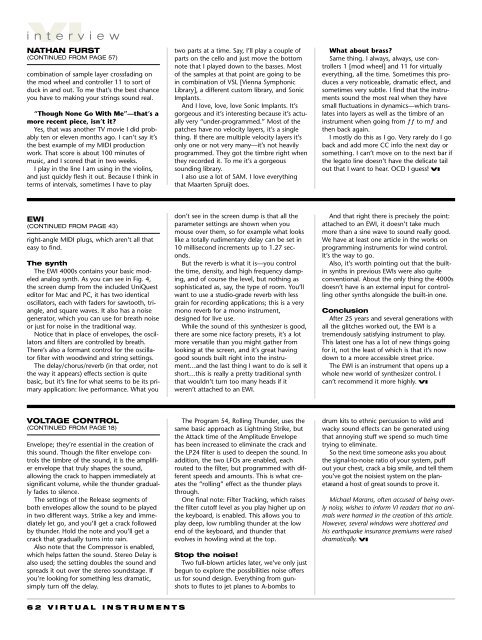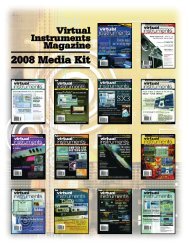Akai EWI 4000m Electric Wind Instrument Akai EWI 4000m Electric ...
Akai EWI 4000m Electric Wind Instrument Akai EWI 4000m Electric ...
Akai EWI 4000m Electric Wind Instrument Akai EWI 4000m Electric ...
Create successful ePaper yourself
Turn your PDF publications into a flip-book with our unique Google optimized e-Paper software.
VI<br />
interview<br />
NATHAN FURST<br />
(CONTINUED FROM PAGE 57)<br />
combination of sample layer crossfading on<br />
the mod wheel and controller 11 to sort of<br />
duck in and out. To me that’s the best chance<br />
you have to making your strings sound real.<br />
“Though None Go With Me”—that’s a<br />
more recent piece, isn’t it?<br />
Yes, that was another TV movie I did probably<br />
ten or eleven months ago. I can’t say it’s<br />
the best example of my MIDI production<br />
work. That score is about 100 minutes of<br />
music, and I scored that in two weeks.<br />
I play in the line I am using in the violins,<br />
and just quickly flesh it out. Because I think in<br />
terms of intervals, sometimes I have to play<br />
<strong>EWI</strong><br />
(CONTINUED FROM PAGE 43)<br />
right-angle MIDI plugs, which aren’t all that<br />
easy to find.<br />
The synth<br />
The <strong>EWI</strong> 4000s contains your basic modeled<br />
analog synth. As you can see in Fig. 4,<br />
the screen dump from the included UniQuest<br />
editor for Mac and PC, it has two identical<br />
oscillators, each with faders for sawtooth, triangle,<br />
and square waves. It also has a noise<br />
generator, which you can use for breath noise<br />
or just for noise in the traditional way.<br />
Notice that in place of envelopes, the oscillators<br />
and filters are controlled by breath.<br />
There’s also a formant control for the oscillator<br />
filter with woodwind and string settings.<br />
The delay/chorus/reverb (in that order, not<br />
the way it appears) effects section is quite<br />
basic, but it’s fine for what seems to be its primary<br />
application: live performance. What you<br />
VOLTAGE CONTROL<br />
(CONTINUED FROM PAGE 18)<br />
Envelope; they’re essential in the creation of<br />
this sound. Though the filter envelope controls<br />
the timbre of the sound, it is the amplifier<br />
envelope that truly shapes the sound,<br />
allowing the crack to happen immediately at<br />
significant volume, while the thunder gradually<br />
fades to silence.<br />
The settings of the Release segments of<br />
both envelopes allow the sound to be played<br />
in two different ways. Strike a key and immediately<br />
let go, and you’ll get a crack followed<br />
by thunder. Hold the note and you’ll get a<br />
crack that gradually turns into rain.<br />
Also note that the Compressor is enabled,<br />
which helps fatten the sound. Stereo Delay is<br />
also used; the setting doubles the sound and<br />
spreads it out over the stereo soundstage. If<br />
you’re looking for something less dramatic,<br />
simply turn off the delay.<br />
62 VIRTUAL INSTRUMENTS<br />
two parts at a time. Say, I’ll play a couple of<br />
parts on the cello and just move the bottom<br />
note that I played down to the basses. Most<br />
of the samples at that point are going to be<br />
in combination of VSL [Vienna Symphonic<br />
Library], a different custom library, and Sonic<br />
Implants.<br />
And I love, love, love Sonic Implants. It’s<br />
gorgeous and it’s interesting because it’s actually<br />
very “under-programmed.” Most of the<br />
patches have no velocity layers, it’s a single<br />
thing. If there are multiple velocity layers it’s<br />
only one or not very many—it’s not heavily<br />
programmed. They got the timbre right when<br />
they recorded it. To me it’s a gorgeous<br />
sounding library.<br />
I also use a lot of SAM. I love everything<br />
that Maarten Spruijt does.<br />
don’t see in the screen dump is that all the<br />
parameter settings are shown when you<br />
mouse over them, so for example what looks<br />
like a totally rudimentary delay can be set in<br />
10 millisecond increments up to 1.27 seconds.<br />
But the reverb is what it is—you control<br />
the time, density, and high frequency damping,<br />
and of course the level, but nothing as<br />
sophisticated as, say, the type of room. You’ll<br />
want to use a studio-grade reverb with less<br />
grain for recording applications; this is a very<br />
mono reverb for a mono instrument,<br />
designed for live use.<br />
While the sound of this synthesizer is good,<br />
there are some nice factory presets, it’s a lot<br />
more versatile than you might gather from<br />
looking at the screen, and it’s great having<br />
good sounds built right into the instrument…and<br />
the last thing I want to do is sell it<br />
short…this is really a pretty traditional synth<br />
that wouldn’t turn too many heads if it<br />
weren’t attached to an <strong>EWI</strong>.<br />
The Program 54, Rolling Thunder, uses the<br />
same basic approach as Lightning Strike, but<br />
the Attack time of the Amplitude Envelope<br />
has been increased to eliminate the crack and<br />
the LP24 filter is used to deepen the sound. In<br />
addition, the two LFOs are enabled, each<br />
routed to the filter, but programmed with different<br />
speeds and amounts. This is what creates<br />
the “rolling” effect as the thunder plays<br />
through.<br />
One final note: Filter Tracking, which raises<br />
the filter cutoff level as you play higher up on<br />
the keyboard, is enabled. This allows you to<br />
play deep, low rumbling thunder at the low<br />
end of the keyboard, and thunder that<br />
evolves in howling wind at the top.<br />
Stop the noise!<br />
Two full-blown articles later, we’ve only just<br />
begun to explore the possibilities noise offers<br />
us for sound design. Everything from gunshots<br />
to flutes to jet planes to A-bombs to<br />
What about brass?<br />
Same thing. I always, always, use controllers<br />
1 [mod wheel] and 11 for virtually<br />
everything, all the time. Sometimes this produces<br />
a very noticeable, dramatic effect, and<br />
sometimes very subtle. I find that the instruments<br />
sound the most real when they have<br />
small fluctuations in dynamics—which translates<br />
into layers as well as the timbre of an<br />
instrument when going from ƒƒ to mƒ and<br />
then back again.<br />
I mostly do this as I go. Very rarely do I go<br />
back and add more CC info the next day or<br />
something. I can’t move on to the next bar if<br />
the legato line doesn’t have the delicate tail<br />
out that I want to hear. OCD I guess! VI<br />
And that right there is precisely the point:<br />
attached to an <strong>EWI</strong>, it doesn’t take much<br />
more than a sine wave to sound really good.<br />
We have at least one article in the works on<br />
programming instruments for wind control.<br />
It’s the way to go.<br />
Also, it’s worth pointing out that the builtin<br />
synths in previous <strong>EWI</strong>s were also quite<br />
conventional. About the only thing the 4000s<br />
doesn’t have is an external input for controlling<br />
other synths alongside the built-in one.<br />
Conclusion<br />
After 25 years and several generations with<br />
all the glitches worked out, the <strong>EWI</strong> is a<br />
tremendously satisfying instrument to play.<br />
This latest one has a lot of new things going<br />
for it, not the least of which is that it’s now<br />
down to a more accessible street price.<br />
The <strong>EWI</strong> is an instrument that opens up a<br />
whole new world of synthesizer control. I<br />
can’t recommend it more highly. VI<br />
drum kits to ethnic percussion to wild and<br />
wacky sound effects can be generated using<br />
that annoying stuff we spend so much time<br />
trying to eliminate.<br />
So the next time someone asks you about<br />
the signal-to-noise ratio of your system, puff<br />
out your chest, crack a big smile, and tell them<br />
you’ve got the noisiest system on the planetæand<br />
a host of great sounds to prove it.<br />
Michael Marans, often accused of being overly<br />
noisy, wishes to inform VI readers that no animals<br />
were harmed in the creation of this article.<br />
However, several windows were shattered and<br />
his earthquake insurance premiums were raised<br />
dramatically. VI



